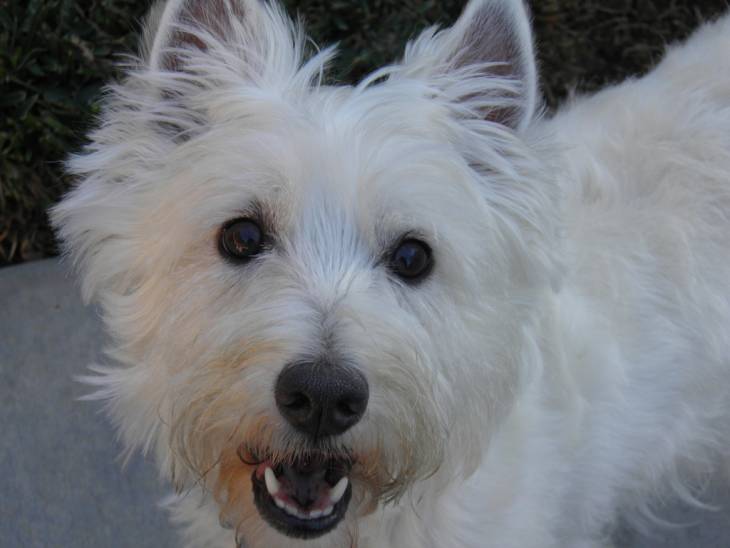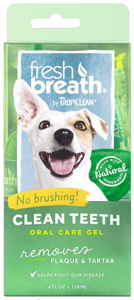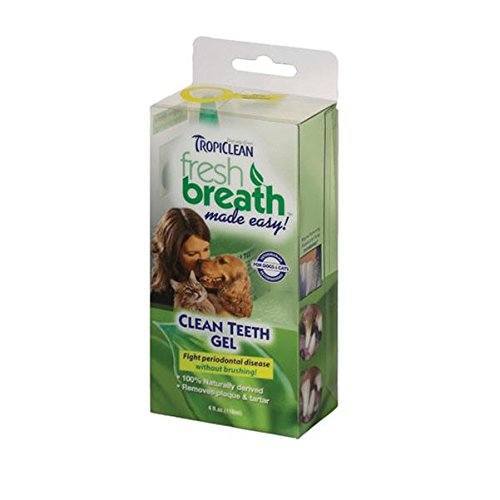What’s the Best Dog Toothpaste on the Market? (Smile!)
A dog’s teeth should last a lifetime, and they can with proper grooming and care. One of the most efficient ways to handle this necessity is to consistently use toothpaste specifically designed for dogs during every teeth cleaning. But which toothpaste works best?
OUR PICKS FOR THE BEST DOG TOOTHPASTE
The Importance of Keeping Your Dog’s Teeth Clean
Keeping your dog’s teeth clean may not get the kind of attention devoted to his coat or his nails, but it is every bit as important to keep his chompers in tip-top fashion. Part of the reason why it’s so vital has to do with the design of your pooch’s maw.
For one thing, a dog’s mouth is more alkaline than ours. Because of this, he’s subject to a higher promotion of plaque formation, which consists of various by-products ranging from food remnants to oral bacteria.
Much as it does with humans, an excess amount of plaque creates a haven for bacteria to fester, particularly if the icky stuff is allowed to proliferate. As the plaque builds up, your pooch’s mouth will try to ward it off biologically. While this may sound good on the surface, it’s actually the impetus of the trouble.
When a dog’s mouth tries to combat plaque and dirty teeth, it results in things like inflammation and tissue destruction. This eventually sets the stage for a wide host of tooth-related diseases such as periodontal disease. These conditions could lead to tooth loss and bad breath; in some cases, it could lead to issues tied to the dog’s blood or organs.
As harrowing as this sounds, these conditions are easily preventable, provided you put the time and effort into taking care of your dog’s teeth. This is best accomplished by brushing your dog’s teeth on a consistent basis. In an ideal situation, you will want to brush his teeth on a daily basis.
Can I Use Human Toothpaste on My Dog?
It may be tempting to simply use the toothpaste you use to clean your teeth on your dog’s not-so-pearly whites. After all, your toothpaste makes your teeth look good – wouldn’t it do the same for my pooch?
Avoid this temptation at all costs. Most toothpastes designed for humans contain fluoride, which is highly poisonous for dogs. While your vet may prescribe fluoride treatments if your pooch has periodontal disease, the substance will do much more harm than good in any other teeth cleaning situation.
Can I Make My Own Toothpaste for My Dog?
If you have the gumption and a little elbow grease, you can create a DIY toothpaste. There are quite a few recipes out there, including some that have seemingly disparate ingredients. The combination of elements may not make much sense to your palate, but your dog may have a difference of opinion.
What to Look for in a Dog Toothpaste
If you aren’t completely confident in making your own toothpaste, leave it up to the professionals. A proper tube of dog toothpaste is specifically formulated to minimize the formation of plaque on your pooch’s teeth. This is especially important to note, considering you may not be able to get to your dog’s teeth daily.
When you start looking for dog toothpaste, the first thing you may notice is that there is an abundance of flavors on the market. Some of these flavors are pleasant to our sensibilities, like vanilla and mint. Other flavors are stuff we’d never consider using for our brushing sessions, like seafood, beef, or poultry.
If you see small sample sizes available, it may be wise to snap up a few of them so you can see which flavor your dog likes. You may already have an inkling as to what he would like based on his diet, but you don’t want to just assume that he’ll take to a toothpaste that tastes like his dinner.
It’s also important to note that the term toothpaste does not automatically correlate to a tube of gooey paste in the canine world like it does in our realm. While paste is certainly an option for your four-legged friend, you’ll also be able to choose from gels, liquid rinses, and sprays.
There are also different methods that the toothpastes deploy to keep your buddy’s teeth looking tip-top. For instance, some toothpastes utilize the power of grain alcohol to clean your pooch’s teeth – an ingredient that makes some owners a bit wary of its usage. Other toothpastes will have antibacterial enzymes, which tend to be gentler.
Ideally, you’ll want to use a toothpaste that will minimize the amount of foam that develops during the brushing process. Too much foam will create an unpleasant sensation in your pooch’s mouth. If he’s not used to getting his teeth brushed, this may make it hard for you to convince him doing so is a good idea.
Notes on Brushing Your Pooch’s Teeth


If you’ve never brushed your pooch’s teeth before, be aware that doing so is a very gentle process. He probably is going to resist you sticking an object in his mouth, so you’re going to have to sell him on the notion.
To get him used to the process, you need to gently massage his lips with your finger one or twice a day for 30 to 60 seconds. After a few weeks, move to the teeth and gums. Once he gets cool with the notion, introduce him to the flavor of dog-formulated toothpaste.
Next, you can introduce him to a toothbrush specifically designed for dogs. These brushes will be smaller than human toothbrushes, and have softer bristles. There are even toothbrushes that you can slip onto your finger, which can allow you to massage his gums along the way.
Finally, you can clean his teeth by brushing his chompers in small, circular motions. Work efficiently, but be sure to concentrate on one area at a time. While it’s ideal to brush your pooch’s teeth daily, you could get away with brushing them two to three times a week.
OUR FINAL RECOMMENDATIONS
Sentry Petrodex VS Dental Kit Dual Toothpaste
One of the most important things to bear in mind, as you're brushing your dog's teeth, is to treat them like you would treat your own pearly whites. This not only means brushing them frequently, that also means making sure the toothbrush itself gets replaced periodically. If you don't, it starts becoming ineffective.
This fact is why a product like Sentry Petrodex VS Dental Kit Dual Toothpaste is worthy of your consideration. It not only comes with a flavored gel toothpaste that will help you remove plaque and freshen breath, but it also comes with a toothbrush that can easily slip onto your finger.
This works because it prevents your dog’s toothbrush from becoming an afterthought. Whenever you run out of toothpaste, simply buy this product again, and toss out the old toothbrush along with the empty tube. It’s a simple task that you may not otherwise think about, but it’s something that will help protect your dog’s teeth on a higher level.
It should be reiterated that you don’t need to necessarily use a paste-based tooth treatment to keep your dog’s teeth looking their best. The Tropiclean Fresh Breath Plaque Remover proves this. Rather than a traditional tooth paste, the product is a spray that you apply to your pooch’s mouth with a squirt.
There are a few advantages to using this spray instead of a brush. Firstly, it is less time-consuming from an overall grooming perspective - all it takes is a couple of drops in your pooch's mouth to protect the chompers from plaque and foul breath. Your pooch may find this process significantly less intrusive than sticking a brush in his mouth.
This time-saving element may make it easier for you to tend to his teeth. If you’re not careful, the rigmarole of brushing your pooch’s may devolve into an unpleasant activity that you “forget” to do every now and again. This quick and easy application minimizes the chance of flimsy excuses on your part to manifest.
Additionally, this product uses natural ingredients like green tea leaf extract and shies away from abrasive chemicals. This may be of particular interest if you’re an owner wary of sticking harsh materials in your pooch’s maw.
Whether you use a paste or a spray, an abrasive substance or an enzymatic gel, the important thing here is that you are taking the steps needed to make sure your dog's teeth are clean and healthy. This will not only allow him to preserve his teeth, but it will also preserve his overall health in ways that you may not readily realize.
Remember, a dog’s teeth should last a lifetime, and he doesn’t have the power or ability to safeguard his teeth like you do. So help your four-legged friend out! He may not be able to communicate his gratitude, but rest assured he’ll be quite appreciative.




